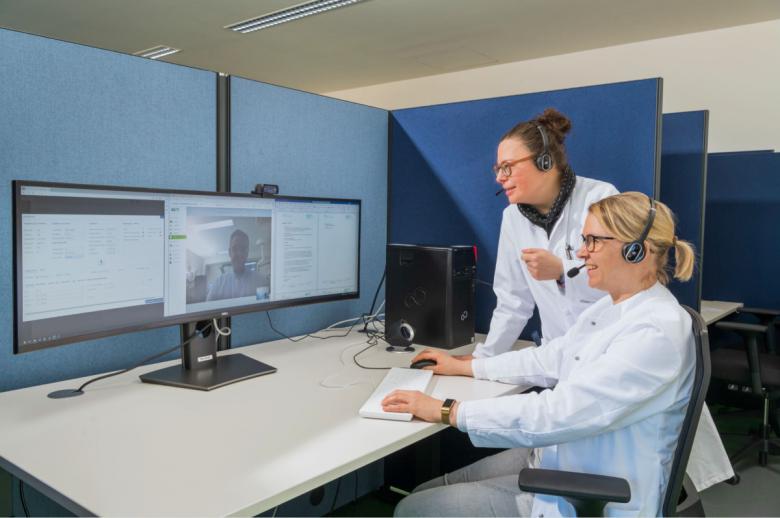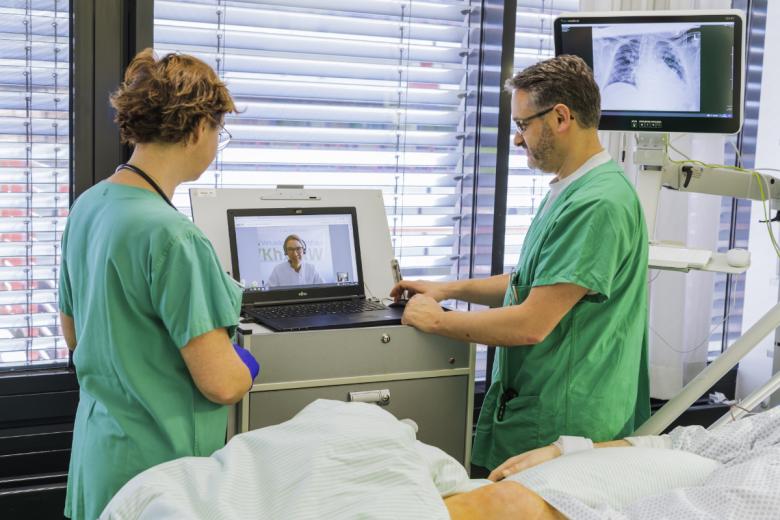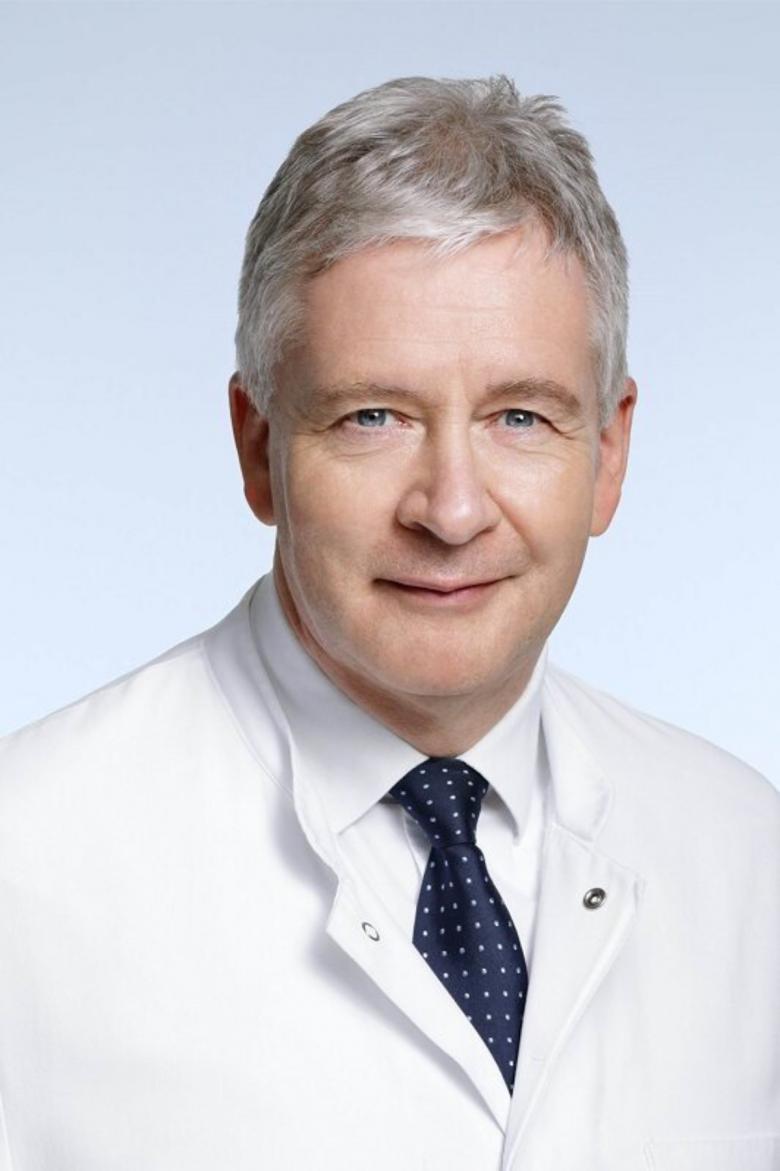Digitization in the healthcare sector: Where is the journey taking us?
Susanna Koeberle
4. April 2024
Teleconsultation in intensive care medicine from a teleconsultation perspective at the Telemedicine Center of the Uniklinik RWTH Aachen (Photo: ZTG GmbH/Artvertise)
Professor Dr. med. Gernot Marx is a specialist in anesthesiology and heads the Clinic for Operative Intensive Medicine and Intermediate Care at the Uniklinik RWTH in Aachen. We spoke to him about the challenges and advantages of digitization.
Hospitals reflect the advances of science. To what extent does advancing digitization change your work?Gernot Marx: It is doing so in many different ways and has been doing so for quite some time. In the field of intensive care medicine in particular, digital documentation has been available to us since the 1990s. Data exchange and a powerful IT infrastructure allow doctors, nurses, and other hospital staff to establish a new form of healthcare. Of course, patients also benefit from this.
It is about the availability of data, faster exchange, and enabling networking between institutions and hospitals. These digital innovations are inducing new processes and structures in healthcare. Telemedicine is a good example of this. Telemedicine enables the expertise and specialist knowledge of colleagues from university hospitals to be made available to doctors and patients in regional hospitals across the board. That is very effective.
During the first wave of the COVID-19 pandemic, for example, we were one of the first hospitals to treat many patients. We were able to immediately share this knowledge digitally via telemedicine with colleagues at other hospitals. As is usual with a new disease, there were lots of questions. I like to call this a living quality network.
This is all the more important today, as there is currently an imbalance due to an ageing society, with fewer and fewer people providing care and more and more people requiring high levels of care. Digital networking can optimize this and thus better maintain care.
The wards must have secure WLAN equipment, for example. The rooms in which telemedicine is practiced must also be equipped accordingly. We have mobile trolleys with cameras and screens. There should also be more space for large screens at the patient's bedside. In the future, we will increasingly work with touch or voice recognition functions. This infrastructure needs to be more accessible and visible for us and for the patients. The devices also have an impact on air conditioning technology. In general, rising temperatures are an issue that requires an architectural response.
I don't know if there are any unimportant ones. In essence, the goal of digitization is to completely digitize the so-called "patient journey" in hospitals. But we're not there yet. The aim is for digital patient files to be available with all important information before admission to the hospital and to be able to make them available again at the end, for example, for outpatient care. The aim is to provide 360-degree support.
In the clinic itself, the radiology department is particularly digital. The intervention and surgical areas, the so-called high-level care areas, are also places where digitization is important. Then there are the administration and laboratories. Diagnosis and treatment are based on a puzzle where you have to aggregate various pieces of information. We want to get to the point where we can identify certain diseases in advance. This is sometimes difficult to recognize when you provide care for a lot of patients with a lot of data. Too much data overwhelms human comprehension. An intensive care patient generates around 1000 data points per hour—here, algorithms based on artificial intelligence for decision support are desirable to be able to recognize life-threatening conditions such as blood poisoning (sepsis) earlier.
Teleintensive medical consultation from the perspective of the consultee. Patient data and image files are discussed in a collegial consultation. (Photo: ZTG GmbH/Artvertise)
Do you see any disadvantages or risks in this development?Ensuring data security is a major challenge—this is, of course, also the case in many non-medical areas. Protection against hacker attacks is very important. At the same time, it is naive to believe that you can achieve one hundred percent security; there will always be a residual risk. It is important that we sensitize ourselves and our employees to this issue. Relevant skills are required: on the one hand, the application but, on the other hand, also the identification of dangers.
No, I don't think that's quite the case. I remember when in the 1990s there was talk of a death computer that calculated and predicted the probability of people dying. However, that doesn't mean that they actually died as a result. At most, it showed how seriously ill someone was. The decisions are within the medical responsibility and are ultimately made by doctors. Computers will not be making decisions in the future either. Computers are not as good at interpreting the individual interplay between data, evidence, and clinical impression. I believe that the fear of being completely at the mercy of technology is unfounded in clinical practice. Computers provide us with important decision-making support.
Certainly, the ergonomics of the equipment play a crucial role. As for the spaces themselves, they need to be spacious enough. Additionally, we need rooms with natural light as well as those without. Data protection must be ensured, meaning that it should not be possible to look into the rooms from outside. On the other hand, patients want be able to see the outside after waking up. This aspect is relatively easy to solve technically.
One important task, for example, is to consistently bring together the individual areas of expertise—medical informatics specialists, computer scientists, and AI experts—in the future. That is why we are building an innovation center for digital medicine here on our campus in Aachen. In this building, we'll bring together all these experts in digitization and artificial intelligence. We are planning meeting points on the individual floors where people will automatically meet each other and get talking.
It is important that the architecture tries to stimulate this exchange. Digitization and standardization mean that we will have more and more data. This will enable us to make ever more accurate forecasts and simulate progressions better. The possibility of personalized medicine is also increasing. None of this is utopian, as the example of one of the most common diseases, sepsis, shows. Using algorithms, we can predict blood poisoning twelve or more hours in advance and thus react early. I am confident that in ten years' time, this development will enable us to practice much more effective medicine than we do today.
Professor Dr. med. Gernot Marx is a specialist in anesthesiology and heads the Clinic for Operative Intensive Care Medicine and Intermediate Care at the Uniklinik RWTH Aachen. (Photo: Uniklinik RWTH Aachen)
You emphasized the importance of knowledge exchange earlier. What should the dialogue between medical professionals and architects look like? What are your wishes regarding this?Architects plan very far in advance, and once the designs are finalized, they're fixed. We medical professionals don't work with such long lead times; in four years, we have one to three development cycles. In many new building projects, we're often brought in so late that our wishes are no longer feasible. You end up with a building that may be beautiful but could actually be more functional. In other words, early involvement is crucial. With virtual reality tools, various things could be tested at an early stage, and we could see together if they work. That way, our inputs could be incorporated into the design accordingly.
We're part of the RWTH University, which includes many different faculties. The RWTH Aachen campus was created with the vision of conducting more research and being able to cooperate with companies and institutions. This is a new model in which new spaces and buildings for research can be created promptly through an investor model. The companies construct the buildings and then rent them to us. We generate rents through projects with various companies, among other things. This shortens the cycles, and we can develop our "technical readiness" faster.
It varies greatly. Some countries are already very advanced. For example, Eastern European countries that had to reposition themselves over twenty years ago and were willing to take risks. Scandinavian countries like Finland and Norway are also very advanced in terms of digitization. Acceptance among the population is greater than in Germany. It's worth noting that the pandemic has certainly given this a significant boost. Many people have realized how useful digitization is.
The pace of development has increased significantly in recent years, including in legislation. Germany, for example, was at the forefront with DiGA (Digital Health Applications); these are apps that doctors can prescribe. People's willingness to use such apps has increased significantly. Overall, it must be said that the dynamics of development in Germany has improved a lot. The European Commission has already established many structures and supported this development with major programs, especially during the COVID-19 pandemic. As a result, we are currently able to build a European reference network. Digitization helps in overcoming crises.


